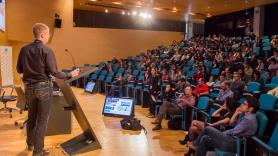3. Dark genome and methylation, other two pillars of epigenetics
“More than 80% of DNA is transcribed to non-coding RNA,” explained Tony Kouzarides, professor of cancer biology at the University of Cambridge. “And nearly half of that DNA is retrovirus inserted into the genome at some point of evolution,” added Simon J. Elsäser of Karolinska Institutet in Stockholm.
Part of that RNA (called micro RNA) can join with others that do code for proteins. In doing so, the union is destroyed, meaning it serves to regulate how much of each protein there is in a cell. But this is also complicated. Other, longer RNA can work differently. Ramin Shiekhattar, director of the Epigenetics Program at the University of Miami, explained that they can join to the DNA itself, for example in areas that work as switches for expression. One example: there is a type of RNA that can switch on the Snai1 gene, which is key to the development of several types of tumors. Snai1 can't be eliminated completely, though, because healthy cells also need a bit of it. That’s why “This RNA makes it possible to control Snai1 just in tumor cells, because it’s almost exclusively found in there,” said Shiekhattar.
The other part of epigenetics is DNA methylation, the union of a chemical group to certain cytosines —one of the four letters— in the ADN. In general, this union involves a closed genome: it impedes it transcription and alterations in these marks can lead to diseases like cancer, schizophrenia or even Alzheimer. Unlike genetics, epigenetics is more flexible, less rigid. Methylation can be reversible, coming and going. These movements are the focus of study for François Fuks, director of the Laboratory of Cancer Epigenetics at the University of Brussels. The TET proteins are very important here, key in removing methylation, and alteration of these proteins seems to be behind some tumors like in some cases of leukemia and melanomas.
To impede transcription, methylation uses proteins that join to it and block anything else from entering. Cristina Cardoso, professor of cell biology and epigenetics at the University of Darmstadt, Germany, calls them “the guardians of the epigenome”. They are so important that a simple mutation in one of their genes, for the MeCP2 protein, causes a devastating disease in young girls called Rett syndrome, which leads to respiratory, neurological (with convulsions and altered movement) and behavioral problems, including traits typically seen in autism.
Epigenetics: Lamarckian inheritance?
According to Darwin’s theories, evolution takes place as a result of mutations to DNA that are passed down to future generations. These mutations are a result of random chance and the environment has little or no impact. His contemporary, maligned scientist Lamarck had a different idea: if a giraffe stretched its neck to reach the leaves at the top of a tree, that stretching could be passed down to its offspring. Epigenetics opens the door to Lamarck being somewhat right about this.
Agouti mice normally have yellow fur. But if their diet is rich in methyl groups, their DNA methylation changes and their fur turns brown. That alone can cause their offspring to be born brown. Part of the Netherlands experienced widespread famine during World War II. As a result, it seems, the children of those Dutch mothers were shorter than usual, as were their grandchildren. Some environmental factor, not strictly genetic, seems to have been passed down. Similarly, certain diets seem to make an individual’s grandchildren more prone to diabetes.
These mechanisms are possible, although we don’t yet know how or to what extent. A majority of epigenetic marks are lost when the zygote is formed: there is something like a reset, known as the Weismann barrier. But some can remain. “Certain methylation marks aren’t lost, some histones we thought were substituted in the sperm seem to be preserved, and non-coding RNA found in the egg can be passed on and function in the first moments of life,” explained Di Croce. “We don’t know to what extent, but yes, epigenetic inheritance may exist.”



